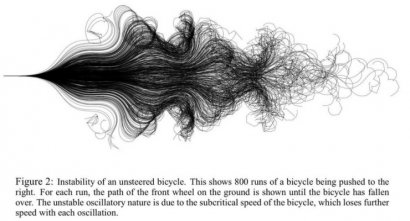 Caltech researcher Matthew Cook has come out with the results of an experiment in which he compares the performance of three controllers – a prescient controller, a human controller, and a two-neuron controller – when they are tasked to control a virtual bicycle and prevent it from falling before reaching a preset destination.
Caltech researcher Matthew Cook has come out with the results of an experiment in which he compares the performance of three controllers – a prescient controller, a human controller, and a two-neuron controller – when they are tasked to control a virtual bicycle and prevent it from falling before reaching a preset destination.
In the paper “It Takes Two Neurons To Ride a Bicycle,” Cook demonstrates that competent bicycle riding does not require a complex mapping from inputs to outputs, with a simple linear combination being “surprisingly competent,” he says.
As a mathematician and computer scientist, Cook proved Stephen Wolfram’s conjecture that the Rule 110 cellular automaton is Turing-complete. His undergraduate studies were at the University of Illinois and the Budapest Semesters in Mathematics program. In the 1980s, Cook qualified as a member of the six-person US team to the International Mathematical Olympiad.
In 1990, Cook went to work for Wolfram Research, makers of the computer algebra system Mathematica. He did his doctoral work in Computation and Neural Systems at Caltech from 1999 to 2005. He is now at the Institute of Neuroinformatics at Zurich in Switzerland and is a graduate student at Caltech.
In the study, Cooks starts with the premise that past attempts to get computers to ride bicycles have required an inordinate amount of learning time – 1,700 practice rides for a reinforcement learning approach, while still failing to be able to ride in a straight line – or have required an algebraic analysis of the exact equations of motion for the specific bicycle to be controlled. Mysteriously, humans do not need to do either of these when learning to ride a bicycle, he says.
“Here we present a two-neuron network that can ride a bicycle in a desired direction (for example, towards a desired goal or along a desired path), which may be chosen or changed at run time,” Cook says in an abstract in the beginning of the study. “Just as when a person rides a bicycle, the network is very accurate for long range goals, but in the short run stability issues dominate the behavior. This happens not by explicit design, but arises as a natural consequence of how the network controls the bicycle.”
Several researchers have worked on the problem of controlling a riderless bicycle. Some, Cook says, have even worked on getting a machine to “learn” on its own how to ride a bicycle, without being told. So far, this has proven to be a difficult task, he says.
First, Cook configured a virtual bicycle as a general-purpose physics simulator for the controllers to work on – meaning ride and control through a computer. Then he factored in the sensory inputs that should be available to the controller, just as a human rider in a real bicycle senses what direction the bike is falling and therefore compensates with balancing hand and body movements to prevent it from falling.
With the sensory inputs factored in, he configured then how the controller’s outputs – in reaction to the sensory inputs – should be converted into forces on the virtual bicycle.
In the virtual bicycle, Cook allowed all the easily perceivable quantities to be available to the interested controller: position, heading, speed, angle of the handlebars and its rate of change, and the amount the bicycle is leaning and its rate of change.
Cook’s configuration allowed the three controllers to apply torque on the back wheel and on the handlebars, but the configuration did not duplicate humans’ sense that made them lean to one side or the other when they ride, to counter-balance a real bicycle.
In the study, Cook found out that “it should not be that hard for a machine to learn to ride a bicycle,” and cites an interesting future direction in possibly building a real bicycle robot, which he said he will not probably pursue as a continuation of the study.
But Cook is optimistic that a causal network may eventually be designed that will lead to computers being able to ride a bicycle, or a self-driving bicycle.
“It is our opinion that a general solution to this problem would have many applications,” Cook concludes.

















